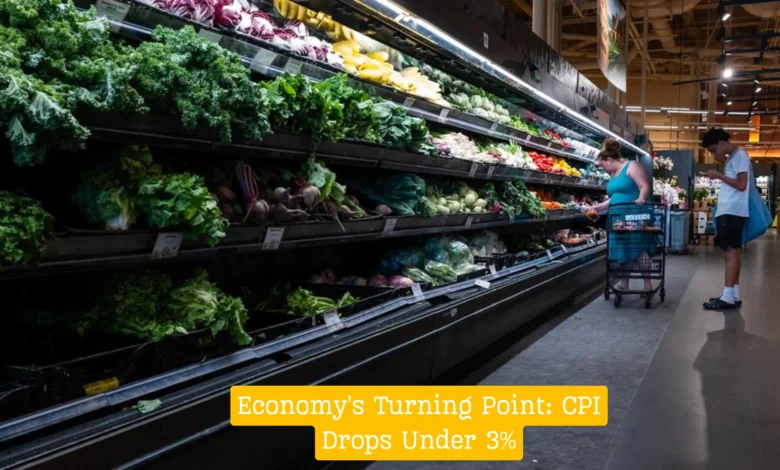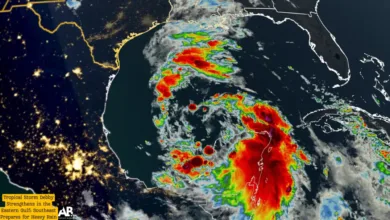Economy’s Turning Point: CPI Drops Under 3%
The Consumer Price Index (CPI), a critical measure of inflation, has recently dropped below 3% for the first time in over two years. This decline marks a significant turning point in the economy, signaling potential changes in the financial landscape that could impact everything from household budgets to investment strategies. Understanding why this shift matters is crucial for anyone looking to navigate the complexities of the current economic environment.

What is the CPI and Why Does It Matter?
The CPI is a measure that examines the weighted average of prices of a basket of consumer goods and services, such as transportation, food, and medical care. It is a key indicator used by economists and policymakers to gauge the level of inflation in the economy. When the CPI rises, it indicates that prices are increasing, which can erode purchasing power and savings. Conversely, a decline in the CPI suggests that inflation is slowing, which can have wide-ranging implications for the economy and individual finances.
Why the Drop Below 3% is Significant
The recent drop in the CPI below 3% is more than just a number; it represents a shift in the economic dynamics that have dominated the past few years. Several factors contribute to this decline, and understanding them can provide insight into what this means for the future.
1. Easing Supply Chain Pressures
One of the primary drivers behind the decline in CPI is the easing of supply chain disruptions that plagued the global economy during the pandemic. As supply chains stabilize, the cost of goods and services has started to normalize, leading to slower price increases.
2. Stabilizing Energy Prices
Energy prices, which spiked dramatically in recent years, have begun to stabilize. This has a direct impact on the CPI, as energy costs are a significant component of the index. Lower energy prices reduce transportation and production costs, contributing to the overall slowdown in inflation.
3. Moderation in Consumer Demand
Another factor contributing to the CPI drop is a moderation in consumer demand. As interest rates have risen and economic uncertainty has increased, consumers have become more cautious in their spending. This has led to a decrease in demand for certain goods and services, putting downward pressure on prices.
4. Impact of Monetary Policy
Central banks, including the Federal Reserve, have been actively working to combat inflation through tighter monetary policy. Higher interest rates make borrowing more expensive, which can dampen consumer spending and investment, leading to slower price increases. The recent CPI data suggests that these policies are beginning to have their intended effect.
What Does This Mean for Inflation?
While the drop in the CPI is a positive sign that inflation is slowing, it’s important to recognize that this does not mean inflation is no longer a concern. Prices are still rising, albeit at a slower pace, and the economy remains vulnerable to a variety of risks that could reignite inflationary pressures.
1. The Role of Core Inflation
It’s also crucial to consider core inflation, which excludes volatile items like food and energy. Core inflation tends to be more stable and can provide a clearer picture of underlying inflation trends. Even with the drop in the headline CPI, core inflation remains elevated, suggesting that price pressures have not fully subsided.
2. Long-Term Inflation Expectations
Another key consideration is long-term inflation expectations. If consumers and businesses believe that inflation will remain high, they may adjust their behavior in ways that could perpetuate inflation. For example, workers may demand higher wages, and companies may preemptively raise prices, leading to a self-fulfilling cycle of inflation.
3. Potential Risks Ahead
There are several potential risks that could disrupt the current trend of slowing inflation. These include geopolitical tensions, unexpected supply chain disruptions, or a sudden spike in energy prices. Any of these factors could cause inflation to accelerate once again, underscoring the importance of remaining vigilant.
How This Turning Point Affects Your Finances
The decline in CPI and the potential stabilization of inflation have several implications for your personal finances. Understanding these impacts can help you make informed decisions about your money.
1. Impact on Savings and Investments
As inflation slows, the real value of your savings is better preserved, which is good news for those with money in low-risk, interest-bearing accounts. However, it’s important to consider that with lower inflation, the returns on certain investments, such as bonds, may also be lower. Diversifying your portfolio and considering investments that can outpace inflation remains crucial.
2. Housing Market Considerations
For those in the housing market, slower inflation could mean a more stable environment for buying or selling property. If interest rates stabilize or decrease in response to slowing inflation, mortgage rates could become more favorable, making home ownership more accessible.
3. Consumer Spending and Debt Management
With inflation easing, consumers may find that their purchasing power is beginning to recover. However, it’s still important to manage debt carefully, especially if interest rates remain elevated. Paying down high-interest debt and avoiding new debt can help you stay on solid financial ground.
4. Wages and Employment
While slower inflation is generally positive, it could also signal slower wage growth. If inflation continues to decelerate, employers may feel less pressure to raise wages, which could impact your income. Staying competitive in the job market and seeking opportunities for skill development can help ensure that your earnings keep pace with any economic changes.






